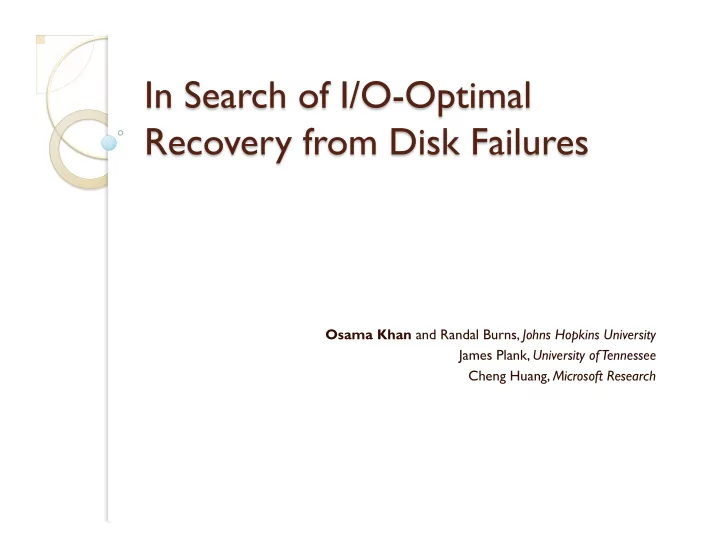

Osama Khan and Randal Burns, Johns Hopkins University James Plank, University of Tennessee Cheng Huang, Microsoft Research
How do we ensure data reliability ◦ Replication (easy but inefficient) ◦ Erasure Coding (complex but efficient) Storage space was a relatively expensive resource MDS codes used to achieve optimal storage efficiency for a given fault tolerance
Emergence of workloads/scenarios where recovery dictates overall I/O performance ◦ System updates ◦ Deep archival stores A traditional k -of- n MDS code would require k I/Os to recover from a single failure Can we do better than k I/Os?
Existing approaches use matrix inversion ◦ Represents one possible solution, not necessarily the one with the lowest I/O cost We have come up with a new way to recover lost data which minimizes the number of I/Os needed for recovery ◦ Its computationally intensive, though all common failure scenarios can be computed apriori ◦ Applicable to any matrix based erasure code
Collection of bits in the codeword whose corresponding rows in the Generator matrix sum to zero ◦ We can decode any one bit as long as the remaining bits in that equation are not lost + { D 0 , D 2 , C 0 } is a decoding equation
Finds a decoding equation for each failed bit while minimizing the number of total elements accessed Enumerate all decoding equations and for each f i ∈ F , determine set E i ◦ F is set of failed bits ◦ E i is set of decoding equations which include f i Goal: Select one equation e i from each E i | F | such that | e i | is minimized i =1
Finding all such e i is NP-Hard but we can convert equations into a directed weighted graph and find the shortest path ◦ Pruning makes it feasible to solve for practical values of | F | and | E i | Cumulative record of 1 D 0 equations applied so far 0 D 1 1 D 2 0 D 3 An edge for each 1 C 0 00110001 equation in E i 0 C 1 0 C 2 0 C 3 Level i Bitstring representation of decoding equation { D 0 , D 2 , C 0 }
F = { D 0 , D 1 }, so f 0 = D 0 and f 1 = D 1 Recovery op*ons Recovery op*ons for f 0 for f 1
Equations Equations from E 1 from E 0
* * * Results similar to existing work
So we have found a way to make recovery I/O of matrix based MDS codes optimal ◦ How about non-MDS codes? Can we achieve better recovery I/O performance at the cost of lower storage efficiency? Replication and MDS codes seem to be the two extrema in this tradeoff
GRID codes allow two (or more) erasure codes to be applied to the same data, each in its own dimension To achieve low recovery I/O coupled with high fault tolerance, we use ◦ Weaver codes: recovery I/O independent of stripe size ◦ STAR codes: builds up redundancy All single failures can be recovered in the Weaver dimension
STAR Weaver nv nh disk with parity disk with data and parity
I/Os for # disks Storage Fault recovery accessed efficiency tolerance GRID(S,W(2,2)) 4 3 31.25% 11 GRID(S,W(3,3)) 6 3 31.25% 15 GRID(S,W(2,4)) 7 4 20.8% 19 I/Os for # disks Storage Fault recovery accessed efficiency tolerance RS(20,31) 20 20 60.6% 11 RS(30,45) 30 30 66.6% 15 RS(30,49) 30 30 61.2% 19
We conjecture that there is a fundamental tradeoff between storage efficiency and recovery I/O ◦ Formal relationship? Programmatic search of generator matrices with optimal recovery I/O schedules ◦ Large search space but reasonably sized systems (100 disks?) may be a feasible option
Thank you!
Recommend
More recommend